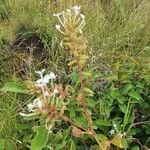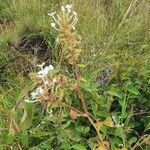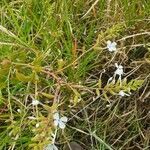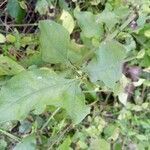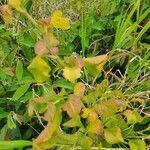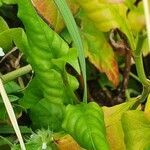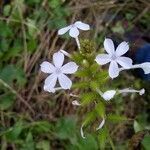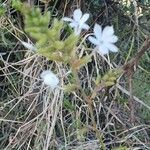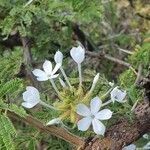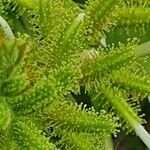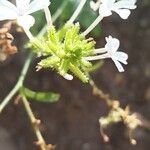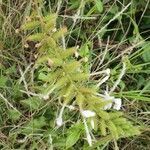Perennial herbs or shrubs, erect, 1--3 m tall, evergreen. Branches spreading, often lianous. Petiole base sometimes auriculate; leaf blade ovate, (3--)5--8(--13) X (1.8--)2.5--4(--7) cm, thin, base cuneate to obtuse, apex acuminate and mucronate. Inflorescences spicate-racemose, (3--)5--70-flowered; peduncle 0.5--1.5 cm, glandular; rachis glandular, (2--)3--8(--15) cm; bracts subovate, 4--6(--8) X (1--)1.5--2(--2.5) mm, apex acuminate; bractlets linear, ca. 2 X 0.5 mm. Calyx 1.0--1.2 cm, to 1.3 cm after anthesis, glandular almost throughout, tube ca. 2 mm in diam. at middle. Corolla white to pale bluish white, tube 1.8--2.2 cm, limb 1.6--1.8 cm in diam.; lobes obovate to oblong-lanceolate, ca. 7 X (2--)4 mm, apex mucronate to acuminate. Anthers blue, ca. 2 mm. Ovary ellipsoid, 5-angular. Style glabrous. Capsules pale yellow-brown, oblong. Seeds red-brown, ca. 7 X 1.5 X 0.6 mm, apex acute. Fl. Oct-Mar, fr. Dec-Apr. 2n = 28.
Shrub about 1 m high, rarely up to 2 m tall and somewhat scandent, striate. Leaves ovate or oblong-ovate to ovate-lanceolate, acute, up to 10 cm long and 6 cm broad but usually only half this size, glabrous, lepidote on the surface, petiolate; petiole 5-15 mm long, stem-clasping and slightly eared at the base. Inflorescence of simple or branched spikes, many-flowered, rhachis glandular, bracteoles oblong and acuminate or ovate or lanceolate, about half length of calyx. Calyx 1.2-1.5 cm long, shortly lobed, with long gland-tipped setae throughout its length, otherwise glabrous. Corolla white, rarely light blue; tube 2-2.5 cm long, limb 1-1.5 cm diam., lobes obovate obtuse or refuse, mucronate. Stamens about equal to the corolla tube; filaments slender, slightly dilated at the base. Ovary glabrous, 5-angled.
Plants herbaceous. Stems prost-rate, climbing, or erect, glabrous. Leaves petiolate (to 1.5 cm) or sessile; blade ovate, lance-elliptic, or spatulate to oblanceolate, (3-)5-9(-15) × (1-)2.5-4(-7) cm, base attenuate, apex acute, acuminate, or obtuse. Inflorescences 3-15(-30) cm, rachises glandular, viscid; floral bracts lanceolate, 3-7 × 1-2 mm. Flowers heterostylous; calyx 7-11(-13) mm, tube glabrous but with stalked glands along length of ribs; corolla white, 17-33 mm, tube 12.5-28 mm (less than 2 times length of calyx), lobes 5-12 × 3-3.5 mm; stamens included. Capsules 7.5-8 mm. Seeds reddish brown to dark brown, 5-6 mm.
A herb. It grows as a shrub to 1-3 m tall. It can spread to 2 m wide. The branches are spreading. The stems are ribbed. The base of the leaf stalk can be ear shaped. The leaf blade is oval. It is 5-8 cm long by 2.5-4 cm wide. They can be larger or smaller. The base is wedge shaped and it tapers to the tip. There are 5-70 flowers in a flower cluster. The flowers are white or pale blue. The fruit is a cylindrical capsule. The seeds are red-brown. They are 7 mm by 1.5 mm.
Straggling shrub. Twigs long, not rooting, 1½-2½ m. Young leaves with caducous small auricles. Racemes 6-30 cm, glands green often red-tipped. Calyx glabrous, glandular all over, green. Corolla tube 18-22 mm, lobes obovate 6-7 mm. Anthers blue-purple. Ovary and style glabrous. Fruit oblong, acute with 5 furrows, calyx patent and recurved.
Shrub, ± 1(-2) m high. Leaves with blade ovate or oblong-ovate to narrowly ovate, ± 100 x 60 mm, lepidote. Flowers: axis of spike glandular; calyx with glandular-capitate setae from base to apex; corolla up to 30 mm long, white; Jul.-Jun.
Shrub, 1 m high, rarely up to 2 m high. Leaves ovate or oblong-ovate to ovate-lanceolate, lepidote. Axis of spike glandular. Calyx with glandular-capitate setae from base to apex. Corolla up to 30 mm long. Flowers white.
Leaf–blades ovate, ovate–lanceolate, elliptic or oblong, rarely obovate, 2·5–13 cm. long, 1–6 cm. wide, acute, acuminate or mucronate, base cuneate, glabrous, often with white waxy dots on lower surface.
Corolla white, sometimes with blue flush at base of lobes, drying pale orange; tube 17–26 mm. long, lobes obovate, 6–10 mm. long, 3–5 mm. broad, acute, with shortly excurrent central nerve.
Creeping herb, scandent or semi–scandent shrub, often much branched, to 2·5 m. tall.
Calyx 10–12 mm. long, prominently ribbed, bearing abundant stiff–stalked glands.
Bracts ovate, ovate–lanceolate or lanceolate, 2–8 mm. long, 1·5–2 mm. wide.
Petiole 2–12 mm. long, amplexicaul at base, occasionally auriculate.
Climbing shrub about 3 ft. high, viscid above
Peduncles bearing prominent sessile glands.
Stems striate, wiry, usually woody.
Calyx teeth up to 1·5 mm. long.
Flowers white, 3/4 in. long
Flowers sweetly scented.
